Post by OldGreenVulture on Jul 27, 2019 14:13:17 GMT
Bearded Vulture
Gypaetus barbatus
Accipitriforme Order – Accipitridae Family
BIOMETRICS :
Length : 100-115 cm
Wingspan : 250-295 cm
Weight : 4,5-7 kg
LONGEVITY: Up to 30 years – Up to 40 in captivity
DESCRIPTION:
Bearded Vulture is a very large raptor with long, pointed wings and long wedge-shaped tail. It has narrower wings than Eurasian Griffon Vulture and Monk (Black) Vulture.
Adult has black wings and tail. The upperwing shows small buff streaks ending in white spots.
Neck and underparts are bright chestnut-orange, due to mineral particles, result of dust-bathing. The original colour is whitish. On the breast, we can see whitish feathers partially coloured orange and blackish.
Underwings and undertail feathers are slaty-black.
The head is whitish, with horn-coloured hooked bill. Lores are black. The eyes are pale yellow, surrounded by conspicuous red eye-ring. But the feature which makes this raptor unmistakable is the small black “beard” of feathers, projecting below the bill base. Legs are short and grey.

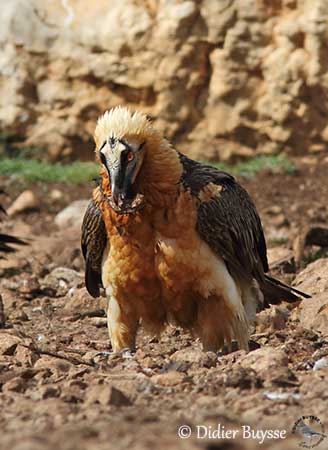

Both sexes are similar, with female slightly larger than male.
The juvenile is dark brown to blackish above, with buffy-black underparts. Eyes and eye-ring are rather reddish-brown. The “beard” is shorter than in adults. The young needs seven years to have the complete adult plumage.

We find two subspecies:
G.b. barbatus, found in NW Africa and SW Europe, Turkey, Egypt, Middle East, Iran, Afghanistan, to Mongolia, and C and NE China.
G.b. meridionalis, found in SW Arabia, and locally in E and S Africa.
VOICE: SOUNDS BY XENO-CANTO
Bearded Vulture is usually silent, but during the flight displays, they utter high-pitched trills, descending and faint for this large species.
The contact call is a weak “piii”.
HABITAT:
Bearded Vulture frequents mainly mountains with rocky areas for nesting and breaking the bones. It may be seen in the surrounding plains, because this large raptor needs open areas with little vegetation to find its food.
Bearded Vulture may be seen up to 8000 metres in the Himalayas, and it breeds between 400 and 4500 metres in India, and between 1000 and 2000 metres in Europe.
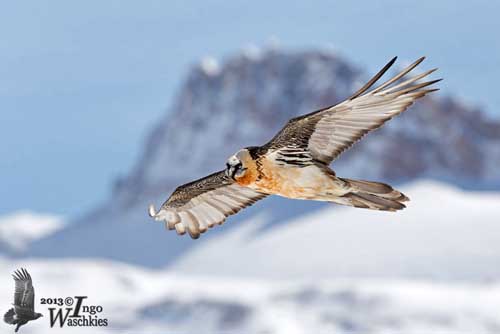
RANGE:
Bearded Vulture’s distribution extends into NW Africa, whereas the race meridionalis is found from Arabian Peninsula to N and E Africa.
The Spanish population increased very well in the last 20 years.
An isolated population lives in the central Drakensberg Mountains in South Africa.
BEHAVIOUR:
Bearded Vulture feeds mainly on large bones (from sheep, goats and wild ungulates), taking both the marrow and the bones themselves.
It also takes meat and skin, but bones are about 85% of its diet.
It is sometimes seen at carcasses of small mammals, and feeds on various birds and reptiles.

Subadult

Bearded Vulture prefers the large leg bones and is able to swallow large bits whole (about 20-25 cm length).
But for the biggest and the largest items, it carries the bone in the air, held in talons, up to 20-80 metres, sometimes more, and drops it onto the rocks below, at usual site named ‘ossuary”.
When the bone is dropped, the bird spirals down after the bone to avoid losing broken bits.
It may repeat this process several times, until to get correct pieces for consumption.
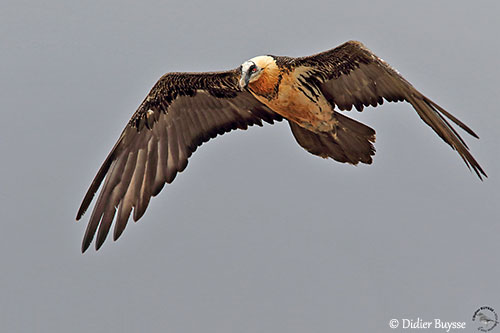
The Bearded Vulture may occasionally steal preys to other birds. It stores the food at nest, but also in caves. It searches for food by flying over its feeding area and may sometimes catch living preys.
The Bearded Vulture begins the displays in mid-winter, with aerial displays. Both mates fly together, one above the other. The bird which is below turns over onto its back and catches the other, and both “fall” almost until the ground.
At this period, they also select the nest-site on cliffs, in caves or ledges.

Bearded Vulture is sedentary in its wide range. The young birds may perform some post-breeding dispersion in summer, but they remain within their natal mountain areas.
Adults are completely sedentary.
FLIGHT:
Bearded Vulture use thermals in gliding flights. It glides with wings at body-level or slightly down-curved.
It glides for long periods over the mountainous areas, without flapping. It is able to soar even in strong winds, thanks to wing and tail adjustments.
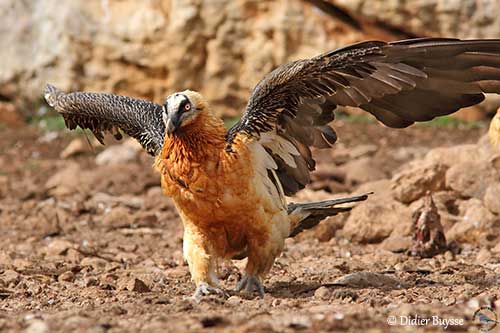
REPRODUCTION:
Bearded Vulture reaches its sexual maturity at 7-8 years of age.
As soon as October-November, both adults search together for a good nest-site. The nest is situated on cliffs, on ledges or in caves. It is made with sticks, and the interior is lined with soft materials such as wool and hair, and other varied items.
Laying occurs between late December and early March, according to the location. Female lays one or two eggs, at 4-5 days intervals. Incubation lasts between 53 and 60 days, by both parents, but probably mainly by female.
Only one chick will hatch or survive. At hatching, it is covered with white or pale grey down. Both adults feed the chick. It fledges about 110 to 130 days later, and it depends on its parents for food during 7 months to one year more.

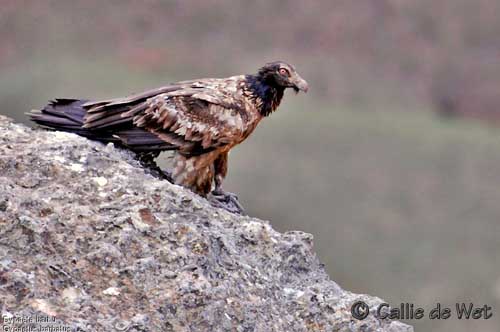
DIET:
Bearded Vulture feeds mainly on bones and marrow, but it may take carrion, some small rodents, or birds and reptiles. It breaks the larger bones by dropping them from the air to an ossuary.
Its feeding areas and the ossuary are regular places where this raptor can be observed every day.

PROTECTION / THREATS / STATUS:
The Bearded Vulture is classified as Near Threatened, with declines in both 19th and 20th centuries.
The main threats are poisoned baits for carnivores, and persecution. Disturbances at nest-sites and reduction of livestock farming play an important role in the declines.
However, thanks to active protection and breeding programs in captivity, some populations are slowly increasing (Spain).
Reintroduction of captive birds gave good results in the Alps.
The creation of feeding stations is another good initiative to help these wonderful birds, the rarest raptors in Europe.
Bearded Vulture is also named “Ossifrage”, “Bone-breaker” and “Bone-eater”, and numerous legends through its wide range celebrate this large raptor.
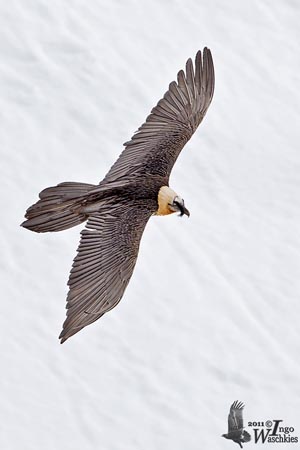
LEGEND :
This large raptor would be responsible of the dead of the Greek poet Eschyle, in the year 456 before JC. The Bearded Vulture was probably abundant in Greece at this moment. It dropped a tortoise, in order to break the carapace for feeding on bones and marrow. Eschyle received the tortoise on the head and this shock killed him.

Fr: Gypaète barbu
All : Bartgeier
Esp : Quebrantahuesos
Ital : Avvoltoio barbuto
Nd : Lammergier
Russe : Бородач
Sd : Lammgam
Photographers:
Didier Buysse
Vision d’Oiseaux
Ingo Waschkies
Bird Photography
Callie de Wet
GALLERY
Text by Nicole Bouglouan
For more information about this raptor, here is an article written by Javier Pastor Gonzalez, in Spanish language: QUEBRANTAHUESOS
Other article: The Old World Vultures
Sources:
HANDBOOK OF THE BIRDS OF THE WORLD Vol 2 by Josep del Hoyo-Andrew Elliot-Jordi Sargatal - Lynx Edicions - ISBN: 8487334156
BIRDS OF PREY OF AFRICA AND ITS ISLANDS by Alan and Meg Kemp - Struik Publishers - ISBN: 1770073698
GUIDE DES RAPACES DIURNES – Europe, Afrique du Nord et Moyen-Orient de Benny Génsbol – Delachaux et Niestlé – ISBN : 2603013270
Avibase (Lepage Denis)
Wikipedia (Wikipedia, The Free Encyclopedia)
www.oiseaux-birds.com/card-bearded-vulture.html
Gypaetus barbatus
Accipitriforme Order – Accipitridae Family
BIOMETRICS :
Length : 100-115 cm
Wingspan : 250-295 cm
Weight : 4,5-7 kg
LONGEVITY: Up to 30 years – Up to 40 in captivity
DESCRIPTION:
Bearded Vulture is a very large raptor with long, pointed wings and long wedge-shaped tail. It has narrower wings than Eurasian Griffon Vulture and Monk (Black) Vulture.
Adult has black wings and tail. The upperwing shows small buff streaks ending in white spots.
Neck and underparts are bright chestnut-orange, due to mineral particles, result of dust-bathing. The original colour is whitish. On the breast, we can see whitish feathers partially coloured orange and blackish.
Underwings and undertail feathers are slaty-black.
The head is whitish, with horn-coloured hooked bill. Lores are black. The eyes are pale yellow, surrounded by conspicuous red eye-ring. But the feature which makes this raptor unmistakable is the small black “beard” of feathers, projecting below the bill base. Legs are short and grey.



Both sexes are similar, with female slightly larger than male.
The juvenile is dark brown to blackish above, with buffy-black underparts. Eyes and eye-ring are rather reddish-brown. The “beard” is shorter than in adults. The young needs seven years to have the complete adult plumage.

We find two subspecies:
G.b. barbatus, found in NW Africa and SW Europe, Turkey, Egypt, Middle East, Iran, Afghanistan, to Mongolia, and C and NE China.
G.b. meridionalis, found in SW Arabia, and locally in E and S Africa.
VOICE: SOUNDS BY XENO-CANTO
Bearded Vulture is usually silent, but during the flight displays, they utter high-pitched trills, descending and faint for this large species.
The contact call is a weak “piii”.
HABITAT:
Bearded Vulture frequents mainly mountains with rocky areas for nesting and breaking the bones. It may be seen in the surrounding plains, because this large raptor needs open areas with little vegetation to find its food.
Bearded Vulture may be seen up to 8000 metres in the Himalayas, and it breeds between 400 and 4500 metres in India, and between 1000 and 2000 metres in Europe.

RANGE:
Bearded Vulture’s distribution extends into NW Africa, whereas the race meridionalis is found from Arabian Peninsula to N and E Africa.
The Spanish population increased very well in the last 20 years.
An isolated population lives in the central Drakensberg Mountains in South Africa.
BEHAVIOUR:
Bearded Vulture feeds mainly on large bones (from sheep, goats and wild ungulates), taking both the marrow and the bones themselves.
It also takes meat and skin, but bones are about 85% of its diet.
It is sometimes seen at carcasses of small mammals, and feeds on various birds and reptiles.

Subadult

Bearded Vulture prefers the large leg bones and is able to swallow large bits whole (about 20-25 cm length).
But for the biggest and the largest items, it carries the bone in the air, held in talons, up to 20-80 metres, sometimes more, and drops it onto the rocks below, at usual site named ‘ossuary”.
When the bone is dropped, the bird spirals down after the bone to avoid losing broken bits.
It may repeat this process several times, until to get correct pieces for consumption.

The Bearded Vulture may occasionally steal preys to other birds. It stores the food at nest, but also in caves. It searches for food by flying over its feeding area and may sometimes catch living preys.
The Bearded Vulture begins the displays in mid-winter, with aerial displays. Both mates fly together, one above the other. The bird which is below turns over onto its back and catches the other, and both “fall” almost until the ground.
At this period, they also select the nest-site on cliffs, in caves or ledges.

Bearded Vulture is sedentary in its wide range. The young birds may perform some post-breeding dispersion in summer, but they remain within their natal mountain areas.
Adults are completely sedentary.
FLIGHT:
Bearded Vulture use thermals in gliding flights. It glides with wings at body-level or slightly down-curved.
It glides for long periods over the mountainous areas, without flapping. It is able to soar even in strong winds, thanks to wing and tail adjustments.

REPRODUCTION:
Bearded Vulture reaches its sexual maturity at 7-8 years of age.
As soon as October-November, both adults search together for a good nest-site. The nest is situated on cliffs, on ledges or in caves. It is made with sticks, and the interior is lined with soft materials such as wool and hair, and other varied items.
Laying occurs between late December and early March, according to the location. Female lays one or two eggs, at 4-5 days intervals. Incubation lasts between 53 and 60 days, by both parents, but probably mainly by female.
Only one chick will hatch or survive. At hatching, it is covered with white or pale grey down. Both adults feed the chick. It fledges about 110 to 130 days later, and it depends on its parents for food during 7 months to one year more.


DIET:
Bearded Vulture feeds mainly on bones and marrow, but it may take carrion, some small rodents, or birds and reptiles. It breaks the larger bones by dropping them from the air to an ossuary.
Its feeding areas and the ossuary are regular places where this raptor can be observed every day.

PROTECTION / THREATS / STATUS:
The Bearded Vulture is classified as Near Threatened, with declines in both 19th and 20th centuries.
The main threats are poisoned baits for carnivores, and persecution. Disturbances at nest-sites and reduction of livestock farming play an important role in the declines.
However, thanks to active protection and breeding programs in captivity, some populations are slowly increasing (Spain).
Reintroduction of captive birds gave good results in the Alps.
The creation of feeding stations is another good initiative to help these wonderful birds, the rarest raptors in Europe.
Bearded Vulture is also named “Ossifrage”, “Bone-breaker” and “Bone-eater”, and numerous legends through its wide range celebrate this large raptor.

LEGEND :
This large raptor would be responsible of the dead of the Greek poet Eschyle, in the year 456 before JC. The Bearded Vulture was probably abundant in Greece at this moment. It dropped a tortoise, in order to break the carapace for feeding on bones and marrow. Eschyle received the tortoise on the head and this shock killed him.

Fr: Gypaète barbu
All : Bartgeier
Esp : Quebrantahuesos
Ital : Avvoltoio barbuto
Nd : Lammergier
Russe : Бородач
Sd : Lammgam
Photographers:
Didier Buysse
Vision d’Oiseaux
Ingo Waschkies
Bird Photography
Callie de Wet
GALLERY
Text by Nicole Bouglouan
For more information about this raptor, here is an article written by Javier Pastor Gonzalez, in Spanish language: QUEBRANTAHUESOS
Other article: The Old World Vultures
Sources:
HANDBOOK OF THE BIRDS OF THE WORLD Vol 2 by Josep del Hoyo-Andrew Elliot-Jordi Sargatal - Lynx Edicions - ISBN: 8487334156
BIRDS OF PREY OF AFRICA AND ITS ISLANDS by Alan and Meg Kemp - Struik Publishers - ISBN: 1770073698
GUIDE DES RAPACES DIURNES – Europe, Afrique du Nord et Moyen-Orient de Benny Génsbol – Delachaux et Niestlé – ISBN : 2603013270
Avibase (Lepage Denis)
Wikipedia (Wikipedia, The Free Encyclopedia)
www.oiseaux-birds.com/card-bearded-vulture.html

